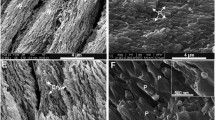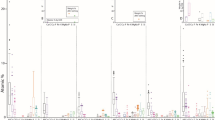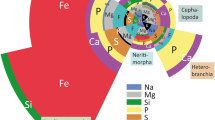Abstract
The majority of the mineral phase of the Lytechinus variegatus tooth is comprised of magnesium containing calcite crystal elements, collectively arranged so that they appear as a single crystal under polarized light, as well as under X-ray or electron irradiation. However, the crystal elements are small, and in spite of the common alignment of their crystal axes, are not the same size or shape in different parts of the tooth. The toughness of the tooth structure arises from the fact that it is a composite in which the crystals are coated with surface layers of organic matter that probably act to inhibit crack formation and elongation. In the growth region the organic components represent a greater part of the tooth structure. In the most heavily mineralized adoral region the primary plates fuse with inter-plate pillars. Using Scanning Electron Microscopy; TOF-SIMS mapping of the characteristic amino acids of the mineral related proteins; and isolation and characterization of the mineral-protected protein we report that the late-forming inter-plate pillars had more than a three-fold greater Mg content than the primary plates. Furthermore, the aspartic acid content of the mineralrelated protein was highest in the high Mg pillars whereas the mineral-protected protein of the primary plates was richer in glutamic acid content.These results suggest that the Asp-rich protein(s) is important for formation of the late developing inter-plate pillars that fuse the primary plates and increase the stiffness of the most mature tooth segment. Supported by NIDCR Grant DE R01-01374 to AV.
Similar content being viewed by others
References
Schroeder J H, Dwornik E J, Papike J J. Primary protodolomite in echinoid skeletons. Geological Society of America Bulletin, 1969, 80: 1613–1615
Wang R Z, Addadi L, Weiner S. Design strategies of sea urchin teeth: structure, composition and michromechanical relations to function. Philosophical Transactions of the Royal Society of London B, 1997, 352: 469–480
Robach J S, Stock S R, Veis A. Mapping of magnesium and of different protein fragments in sea urchin teeth via secondary ion mass spectroscopy. Journal of Structural Biology, 2006, 155: 87–95
Stock S R, Barss J, Dahl T, et al. X-ray absorption microtomography (microCT) and small beam diffraction mapping of sea urchin teeth. Journal of Structural Biology, 2002, 139: 1–12
Veis D J, Albinger T M, Clohisy J, et al. Matrix proteins of the teeth of the sea urchin Lytechinus variegatus. Journal of Experimental Zoology, 1986, 240: 35-46
Veis A, Barss J, Dahl T, et al. Mineral related proteins of the sea urchin teeth. Lytechinus variegatus. Microscopy Research and Technique, 2002, 59: 342–351
Veis A, Dahl T, Barss J. The progress of mineral deposition within the developing tooth of the sea urchin Lytechinus variegatus and its relation to specialized matrix proteins. In: Heinzeller T, Niebelsick J H. Echinoderms: Munchen, IEC2003. London: Taylor and Francis, 2004, 365–370
Alvares K, Dixit S N, Barss J, et al. The proteome of the developing tooth of the sea urchin, Lytechinus variegatus: Mortalin is a constituent of the developing cell syncytium. Journal of Experimental Zoology, 2007, 308B: 357–370
Alvares K, Dixit S N, Lux E, et al. Echinoderm phosphorylated proteins UTMP 16 and UTMP19 have different functions in sea urchin tooth mineralization. (Submitted, 2008)
Maruyama K, Mikawa T, Ebashi S. Detection of calcium binding proteins by 45Ca autoradiography on nitrocellulose membrane after sodium dodecyl sulfate gel electrophoresis. Journal of Biochemistry, 1984, 95: 511–519
Livingston B T, Killian C E, Wilt F, et al. A genome-wide analysis of biomineralization-related proteins in the sea urchin Strongylocentrotus purpuratus. Developmental Biology, 2006, 300: 225–348
Cheers M S, Ettensohn C A. P16 is an essential regulator of skeletogenesis. Developmental Biology, 2005, 283: 384–396
Robach J R, Stock S R, Veis A. Transmission electron microscopy characterization of macromolecular domain cavities and microstructure of single-crystal calcite tooth plates of the sea urchin Lytechinus variegatus. Journal of Structural Biology, 2005, 151: 18–29
Author information
Authors and Affiliations
Corresponding author
Rights and permissions
About this article
Cite this article
Veis, A., Alvares, K., Dixit, S.N. et al. Characterization of two distinctly different mineral-related proteins from the teeth of the Camarodont sea urchin Lytechinus variegatus: Specificity of function with relation to mineralization. Front. Mater. Sci. China 3, 163–168 (2009). https://doi.org/10.1007/s11706-009-0032-1
Received:
Accepted:
Published:
Issue Date:
DOI: https://doi.org/10.1007/s11706-009-0032-1




